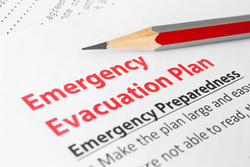 You are at work, and there’s an emergency! People are safe, but what is at risk? What resources do you need to protect them? Who can help?
You are at work, and there’s an emergency! People are safe, but what is at risk? What resources do you need to protect them? Who can help?
Thinking about the worst that could happen is an uncomfortable task, yet if a natural disaster strikes or a fire breaks out, thorough preparation could well be what saves your organization’s assets and documents.
The new BS ISO 21110:2019, Information and documentation — Emergency preparedness and response, provides an outline for preparing for, responding to and recovering from an emergency in your workplace. The standard is not about human lives but specifically about immobile irreplaceable assets.
It sets out how you can put flexible and comprehensive arrangements in place to respond to small events, which can be scaled up for larger emergencies.
It’s orientated towards the heritage sector, with a focus on the rescue and preservation of records and artefacts, yet the bulk of its lessons can be applied to many organizations’ assets.
Making decisions
If disaster strikes, you will need to make several key decisions fast, and emergencies can make the most level-headed people panic. Therefore, it’s best to have decided in advance what needs to be done and who will be responsible.
The standard sets out how to prepare for an event that forces the relocation of a collection or archive.
In the case of a museum affected by a small flood, for example, somebody will need to take the decision to move the collection out of the way.
Such a decision depends upon factors such as human safety, available means, evacuation routes and the risk of building collapse.
Other people will be responsible for communicating this to staff, the public and the authorities.
Another key area of action will be in coordinating response teams, planning an evacuation route, logistics and transport. This may entail liaising with others outside the organization, such as the police, to escort transport.
Items in the collection will need to be packed carefully and registered as they leave the damaged site, and registered again on arrival at the alternative location.
The standard provides a useful template that you can adapt to the needs of your own organization.
Emergency supplies
You should keep an easy-to-carry or easy-to-push emergency kit for immediate use, which must always include personal protective equipment.
In the heritage sector, this kit should also contain everything you might need in the first instance to protect, evacuate and stabilize your collections.
It should be supplemented by equipment that can be found or bought elsewhere on your site.
The template supplied in this publication covers:
- health and safety equipment, such as gloves and goggles;
- equipment you might need in the affected zone, such as tarps, tape and fans;
- equipment for a treatment area, such as ziplock bags for damaged items; and
- communications kit, such as mobile phones and walkie talkies.
You should also have a list to hand of service suppliers who can help in the aftermath of an emergency, such as companies that control mould and damp, security contractors and conservators.
Make sure you check your emergency supplies and lists regularly and update them if necessary.
The role of stakeholders
You should also identify in advance what stakeholders would be affected, and what their roles should be at each stage of the incident and recovery. In terms of first response, you might need to contact the police, fire brigade and other emergency services. You should also communicate with neighbours if the emergency could affect them.
In the immediate aftermath, you will also need to speak to your insurance provider and possibly the media. Local officials and agencies should also be involved.
Contractors, non-profit agencies and donors could be vital for rebuilding efforts. Other sector-relevant bodies, such as the International Council of Museums, could provide vital expertise.
By identifying all stakeholders and their potential roles in advance, you are maximizing your chances of protecting your organization’s archives and artefacts and swiftly restoring it to its former glory.
Buy the standard
This standard provides a context for key emergency planning and response and recovery moves for the protection and conservation of your assets.
Although there is no single approach that covers every site, this publication enables you to plan an approach that meets your organization’s needs, to be carried out in conjunction with other relevant plans.
It addresses the consequences of an emergency event, not the causes.
BS ISO 21110:2019, Information and documentation — Emergency preparedness and response, is available from the BSI shop: https://shop.bsigroup.com/ProductDetail?pid=000000000030362346

 You are at work, and there’s an emergency! People are safe, but what is at risk? What resources do you need to protect them? Who can help?
You are at work, and there’s an emergency! People are safe, but what is at risk? What resources do you need to protect them? Who can help?